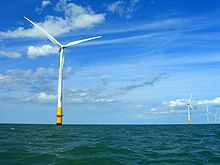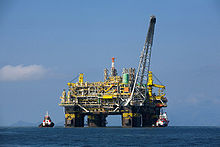- Offshore construction
-
Offshore construction is the installation of structures and facilities in a marine environment, usually for the production and transmission of electricity, oil, gas and other resources.
Construction in the offshore environment is a difficult and dangerous activity. Construction and pre-commissioning is typically performed as much as possible on land or inshore areas. To optimize the costs and risks of installing large offshore platforms, different construction strategies have been developed.
One strategy is to fully construct the offshore facility inshore, and tow the installation to site floating on its own buoyancy. Bottom founded structure are lowered to the seabed by de-ballasting (see for instance Condeep or Cranefree), whilst floating structures are held in position with substantial mooring systems.
The size of offshore lifts can be reduced by making the construction modular, with each module being constructed onshore and then lifted using a crane vessel into place onto the platform. A number of very large crane vessels were built in the 1970s which allow very large single modules weighing up to 14,000 tonnes to be fabricated and then lifted into place.
Specialist floating hotel vessels known as flotels are used to accommodate workers during the construction and hook-up phases. This is a high cost activity due to the limited space and access to materials.
Oil platforms are key fixed installations from which drilling and production activity is carried out. Drilling rigs are either floating vessels for deeper water or jack-up designs which are a barge with liftable legs. Both of these types of vessel are constructed in marine yards but are often involved during the construction phase to pre-drill some production wells. Other key factors in offshore construction are the weather window which defines periods of relatively light weather during which continuous construction or other offshore activity can take place. Safety is another key construction parameter, the main hazard obviously being a fall into the sea from which speedy recovery in cold waters is essential.
The main types of vessels used for pipe laying are the "Derrick Barge (DB)", the "Pipelay Barge (LB)" and the "Derrick/Lay Barge (DLB)" combination. Diving Bells in offshore construction are mainly used in water depths greater than 120 ft, less than that, the divers use a metal basket driven from an "A" frame from the deck. The basket is lowered to the water level, then the divers enter the water from it to a maximum of 120 ft. Bells can go to 1500 ft, but are normally used at 400 to 800 ft.
Offshore construction includes the design, construction, and/or repair of offshore structures, both commercial and military, including:
-
- Subsea oil and gas developments
- Offshore platforms - Fixed Platforms, Semi-submersibles, Spars, TLPs, FPSOs, etc.
- Floating Oil and Gas Platforms - Semi-submersibles, Spars, Tension-leg platforms (TLP's), FPSO's, etc.
External links
Ocean energy Wave power Australia • New Zealand
Tidal power Osmotic power Other Marine current power • Offshore construction • Ocean thermal energy conversion • Pelamis wave energy converter • • SDE Sea Waves Power Plant • Wind power (offshore) • Wave farmCategories:- Coastal construction
- Offshore engineering
-
Wikimedia Foundation. 2010.


